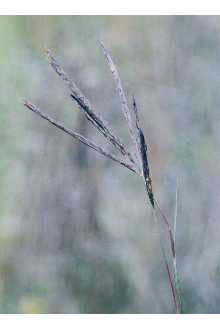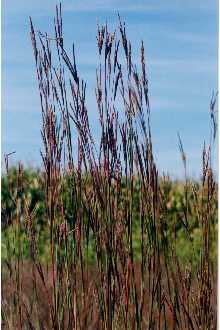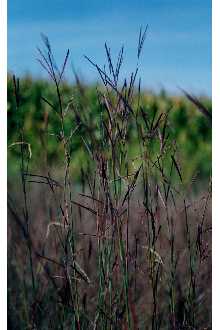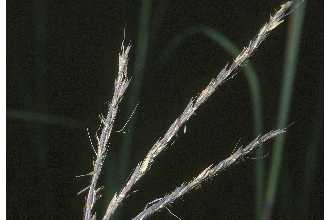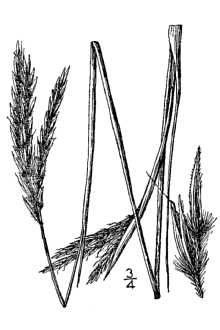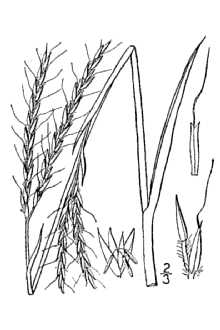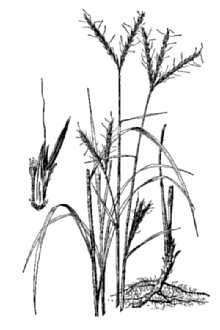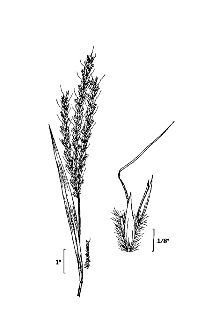Andropogon furcatus Muhl. ex Willd.
Scientific Name: Andropogon furcatus Muhl. ex Willd.
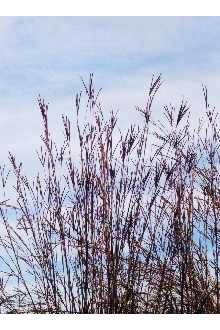
| General Information | |
|---|---|
| Usda Symbol | ANFU5 |
| Group | Monocot |
| Life Cycle | Perennial |
| Growth Habits | Graminoid |
| Native Locations | ANFU5 |
Plant Guide
Alternate Names
Bluejoint beardgrass, poptillo gigante, turkeyfoot, Andropogon chrysocomus, Andropogon furcatus, Andropogon gerardii var. chrysocomus, Andropogon hallii var. grandiflorus, Andropogon provincialis, Andropogon tennesseensis, Sorghum provinciale.
Uses
Conservation: Big bluestem is the dominant grass species of the Midwestern tallgrass prairie. It is mixed with other native prairie species for prairie restoration and highway revegetation. While it does best in moist soils, it can be used for mine reclamation, logging road restoration and other restoration areas that have sandy or droughty conditions. Erosion control: Big bluestem is planted to stabilize soil. Rhizomes are typically 1 to 2 inches below the soil surface, while the main roots can extend downward to 10 feet. Big bluestem is also planted to provide aboveground protection against wind erosion. It is used for road cuts, pipelines, detention basin slopes, and areas that need temporary cover during the restoration process. Ethnobotanic: Chippewa Indians used the root of big bluestem as a diuretic and to alleviate stomach pains. Extracts of the leaf blades were used as a wash for fevers or as an analgesic. The plants were also used to fasten the support poles of dwellings. Moist grass was laid on hot stones to prevent steam from escaping during cooking. It was also used to cover fruit during ripening and under fruit while drying. J. Anderson 2002 USDA-NRCS PLANTS Database Forage: Big bluestem is a high quality forage species for all classes of livestock. Crude protein content of 16-18% is maintained from May through August but drops below 6% in September and October. It is often cultivated as a pasture grass and for hay-making. Landscaping: Big bluestem is used in wildflower meadows and prairie plantings. It is also effective as a rear border or accent in native plant gardens. Wildlife: Big bluestem provides shelter for nesting birds and insects. Songbirds and prairie chickens consume the seeds while white-tailed deer and bison graze vegetative parts.
Legal Status
Status
Status
Please consult the PLANTS Web site (http://plants,usda,gov) and your State Department of Natural Resources for this plant’s current status (e,g, threatened or endangered species, state noxious status, and wetland indicator values), , Use soil moisture sensors to measure the soil moisture of Andropogon furcatus Muhl. ex Willd..
Weediness
This plant is invasive in some regions or habitats and may displace desirable vegetation if not properly managed. Please consult with your local NRCS Field Office, Cooperative Extension Service office, or state natural resource or agriculture department regarding its status and use.
Description
General: Grass Family (Poaceae). Big bluestem is a perennial warm-season grass. It can be distinguished from other warm-season grasses by blue coloration at the base of the culm and purplish, 3-parted flower clusters that resemble a turkey’s foot. The culms are erect, up to 3 m tall, stout, and are usually covered with a blue-tinted waxy layer. Leaf blades are flat,
Adaptation
The USDA hardiness zones for big bluestem are 4 to 9. It is best adapted to moist, sandy or clay loams but also occurs in dry or shallow soils. It does well in full sun or partial shade. Prairie conditions, like low nutrient and moisture content, have conditioned big bluestem for use in well-drained soil with low fertility. It is not tolerant of heavy clays, extremely wet bottomlands, deep sands, high salinity, or high lime. Big bluestem is generally shorter in the northern portion of its range, and taller in the southern portion of its range. It is a rhizomatous, sod-forming grass in the tallgrass prairie and has a bunchgrass appearance in more arid regions.
Establishment
Collect big bluestem seeds when the seed head no longer has a creamy center, usually in September and October. Dry seeds in paper bags for 2 to 4 weeks. Seeds can be stored up to 7 months at 50oF and 50% humidity. Cold stratification (40oF, 35% humidity) may improve germination uniformity. Fill germination trays or pots with moist soil, compacted at bottom. Sow seeds by hand, covering with a thin layer of soil. Keep soil evenly moist during germination and do not use fertilizer. Greenhouse establishment will occur at alternating day/night temperatures (set at 75/65oF) and 12-14 daylight hours (may be extended artificially). Transplant seedlings into plug cells. Soil does not need to be consistently moist at this stage. In early to late spring, move plugs to cold frame. Seedlings are ready for outplanting when the plant and soil can be completely pulled from the pot as one unit. Outplanting can take place from late May to early October. Seeds can be sown directly outside from late winter to early spring. Emergence will occur in 4 weeks with several irrigations. Plants will be ready for harvest in mid-summer to late fall. First-season growth is often slow. Rhizomatic regeneration in following years increases the growth rate.
Management
Underground rhizomes resprout following fire disturbance. Regeneration is slow if fire occurs during the summer (active growth stage). Regeneration following springtime fire is much more vigorous because the rhizomes have winter-stores of carbohydrates. Big bluestem can withstand substantial grazing. However if it is continually grazed closer than 6 to 8 inches, it will be out competed by other grass species. It is highly palatable to livestock during spring and summer and becomes coarse and less palatable during the fall and winter. Hay should be mowed in early to mid-summer to maintain high nutrition quality. Cultivars, Improved, and Selected Materials (and area of origin) NRCS Plants Materials Program (PMC) has released several cultivars of big bluestem. The Bismarck, ND PMC released 'Bison' for its adaptation to northern climates. It is used for erosion control, upland game bird cover and nesting, nature trails, rural beautifica-tion and other native plantings. The Knox City, TX PMC released ‘Eldorado’ and ‘Earl’ cultivars for their forage potential. Other cultivars include ‘Kaw’ (Manhattan, KS), ‘Niagara’ (Big Flats, NY), and ‘Rountree’ (Elsberry, MO).
Control
Please contact your local agricultural extension specialist or county weed specialist to learn what works best in your area and how to use it safely. Always read label and safety instructions for each control method.
References
Anderson, J. 2002. USDA-NRCS PLANTS Database, Version 3.5 (http://plants.usda.gov, 18 January 2004). National Plant Data Center, Baton Rouge.
Ethnobotanical
studies in the American Southwest III. The ethnobiology of the Chiricahua and mescalero Apache. University of New Mexico Bulletin 4(5): 1-63, Pp. 36-40. Gilmore, M.R. 1919. Uses of plants by the Indians of the Missouri River region. SI-BAE Annual Report #33, Pp. 68-69. Institute for Systematic Botany. 2002. Andropogon gerardii. Atlas of Florida Vascular Plants. (http://www.plantatlas.usf.edu/main.asp?plantID=668, 13 Jan 2004). University of South Florida. Tampa. Kansas Wildflowers & Grasses. 2004. Big bluestem. (http://www.lib.ksu.edu/wildflower/bigbluestem.html, 13 Jan 2004). Kansas State University, Manhattan. Knapp, A.K. 1985. Effect of fire and drought on the ecophysiology of Andropogon gerardii and Panicum virgatum in a tallgrass prairie. Ecology 66(4): 1309-1320. Knox City Plants Materials Center. 1985. Notice of release: ‘Eldorado’ engelmanndaisy (Engelmannia pinnatifida). pp. 2. ID #1473. Soil
Fact Sheet
Uses
Erosion control: Big bluestem is a top choice for erosion control plantings on sites with moderately well drained to excessively well drained soils. Generally, it is planted in combination with other warm season grasses on these sites. Livestock: Big bluestem is one of the most palatable warm season grasses and is preferred over switchgrass by livestock. Therefore, in pastures, it should be planted alone for best management, especially where continuous or extensive grazing practices are used. It can be mixed with other species for intensive, rotational grazing. Wildlife: Birds and mammals use big bluestem for nesting and escape cover in summer and winter. It resists lodging under snow cover almost as well as switchgrass, thereby contributing to spring nesting habitat.
Status
Please consult the PLANTS Web site and your State Department of Natural Resources for this plant’s current status (e, Use soil moisture sensors to measure the soil moisture of Andropogon furcatus Muhl. ex Willd..,g, threatened or endangered species, state noxious status, and wetland indicator values),
Description
Andropogon gerardii, big bluestem, is a native, perennial, warm season grass that occurs from the short grass prairie region to the Atlantic Ocean. It is tufted, forms sod, and has short, scaly rhizomes. Big bluestem is tall, reaching a height of 6 to 8 feet on most sites where it is protected from grazing. It is very leafy at the base, with some leaves carried up on the stem. The seed heads normally have 3 spikelets that appear like a ‘turkey foot.’ Robert H. Mohlenbrock USDA NRCS 1995 Northeast Wetland Flora @USDA NRCS PLANTS
Adaptation and Distribution
Distribution
Distribution
Big bluestem is climatically adapted throughout the Midwest and Northeast on moderately well drained through excessively well drained soils. It is adapted to a range of other soil limitations such as shallow depth, low pH, and low fertility. For a current distribution map, please consult the Plant Profile page for this species on the PLANTS Website.
Establishment
Big bluestem should be seeded as early in the spring as possible. Conventional tillage should be used where practical. Where no-till must be used due to slope, stoniness, or other reasons, the sod control should be performed in the fall to permit early spring planting. The seeding rate for broadcast or no-till methods should be 7 to 12 pounds PLS per acre. When drills are used to plant, debearded seed must be utilized unless the drill has a chaffy seed box. When the seed is broadcast, a packer should be utilized to firm the seedbed and incorporate the seed 1/4 to 1/2 inch (3/4 inch on very droughty sites) as if alfalfa was being planted. No nitrogen fertilizer should be applied during the establishment year unless no weed competition is expected. If pH is below 5.5, lime is recommended during site preparation or the fall prior to no-till plantings.
Plant Traits
Growth Requirements
| Drought Tolerance | High |
|---|---|
| Fertility Requirement | Medium |
| Fertility Requirement | Low |
| Fertility Requirement | Low |
| Fertility Requirement | Low |
| Fertility Requirement | Low |
| Drought Tolerance | High |
| Drought Tolerance | High |
| Drought Tolerance | High |
| Drought Tolerance | High |
| Drought Tolerance | High |
| Drought Tolerance | High |
| Drought Tolerance | High |
| Fertility Requirement | Medium |
| Drought Tolerance | High |
| Drought Tolerance | High |
| Cold Stratification Required | No |
| Cold Stratification Required | No |
| Cold Stratification Required | No |
| Cold Stratification Required | No |
| Cold Stratification Required | No |
| Cold Stratification Required | No |
| Cold Stratification Required | No |
| Cold Stratification Required | No |
| Cold Stratification Required | No |
| Cold Stratification Required | No |
| Fire Tolerance | High |
| Frost Free Days, Minimum | 190 |
| Frost Free Days, Minimum | 180 |
| Frost Free Days, Minimum | 180 |
| Frost Free Days, Minimum | 180 |
| Frost Free Days, Minimum | 180 |
| Frost Free Days, Minimum | 155 |
| Frost Free Days, Minimum | 155 |
| Frost Free Days, Minimum | 120 |
| Frost Free Days, Minimum | 120 |
| Frost Free Days, Minimum | 120 |
| Fire Tolerance | High |
| Fire Tolerance | High |
| CaCO3 Tolerance | High |
| Fire Tolerance | High |
| Fire Tolerance | High |
| Fire Tolerance | High |
| Fire Tolerance | High |
| Fire Tolerance | High |
| Fire Tolerance | High |
| Fire Tolerance | High |
| Fertility Requirement | Medium |
| Fertility Requirement | Medium |
| Fertility Requirement | Medium |
| Fertility Requirement | Medium |
| Adapted to Fine Textured Soils | Yes |
| Adapted to Medium Textured Soils | Yes |
| Adapted to Medium Textured Soils | Yes |
| Adapted to Medium Textured Soils | Yes |
| Adapted to Medium Textured Soils | Yes |
| Adapted to Fine Textured Soils | Yes |
| Adapted to Fine Textured Soils | Yes |
| Adapted to Fine Textured Soils | Yes |
| Adapted to Fine Textured Soils | Yes |
| Adapted to Fine Textured Soils | Yes |
| Adapted to Fine Textured Soils | Yes |
| Adapted to Fine Textured Soils | Yes |
| Adapted to Fine Textured Soils | Yes |
| Adapted to Medium Textured Soils | Yes |
| Adapted to Fine Textured Soils | Yes |
| Adapted to Coarse Textured Soils | Yes |
| Adapted to Coarse Textured Soils | Yes |
| Adapted to Coarse Textured Soils | Yes |
| Adapted to Coarse Textured Soils | Yes |
| Adapted to Coarse Textured Soils | Yes |
| Adapted to Coarse Textured Soils | Yes |
| Adapted to Coarse Textured Soils | No |
| Adapted to Coarse Textured Soils | No |
| Adapted to Coarse Textured Soils | No |
| Adapted to Coarse Textured Soils | No |
| Anaerobic Tolerance | Medium |
| CaCO3 Tolerance | High |
| CaCO3 Tolerance | High |
| CaCO3 Tolerance | High |
| CaCO3 Tolerance | High |
| CaCO3 Tolerance | High |
| CaCO3 Tolerance | High |
| CaCO3 Tolerance | High |
| CaCO3 Tolerance | High |
| CaCO3 Tolerance | High |
| Anaerobic Tolerance | Medium |
| Anaerobic Tolerance | Medium |
| Anaerobic Tolerance | Medium |
| Temperature, Minimum (°F) | -9 |
| Anaerobic Tolerance | Medium |
| Anaerobic Tolerance | Medium |
| Anaerobic Tolerance | Medium |
| Anaerobic Tolerance | Medium |
| Anaerobic Tolerance | Medium |
| Anaerobic Tolerance | Medium |
| Adapted to Medium Textured Soils | Yes |
| Adapted to Medium Textured Soils | Yes |
| Adapted to Medium Textured Soils | Yes |
| Adapted to Medium Textured Soils | Yes |
| Adapted to Medium Textured Soils | Yes |
| Root Depth, Minimum (inches) | 20 |
| Salinity Tolerance | Medium |
| Salinity Tolerance | Medium |
| Salinity Tolerance | Medium |
| Salinity Tolerance | Low |
| Root Depth, Minimum (inches) | 20 |
| Root Depth, Minimum (inches) | 20 |
| Root Depth, Minimum (inches) | 20 |
| Root Depth, Minimum (inches) | 20 |
| Root Depth, Minimum (inches) | 20 |
| Root Depth, Minimum (inches) | 20 |
| Root Depth, Minimum (inches) | 20 |
| Root Depth, Minimum (inches) | 20 |
| Salinity Tolerance | Medium |
| Root Depth, Minimum (inches) | 18 |
| Precipitation, Minimum | 20 |
| Precipitation, Minimum | 13 |
| Precipitation, Minimum | 12 |
| Precipitation, Minimum | 12 |
| Precipitation, Minimum | 12 |
| Precipitation, Minimum | 12 |
| Precipitation, Minimum | 12 |
| Precipitation, Minimum | 12 |
| Precipitation, Minimum | 12 |
| Precipitation, Minimum | 12 |
| Shade Tolerance | Intolerant |
| Temperature, Minimum (°F) | -46 |
| Temperature, Minimum (°F) | -43 |
| Temperature, Minimum (°F) | -39 |
| Temperature, Minimum (°F) | -38 |
| Temperature, Minimum (°F) | -36 |
| Temperature, Minimum (°F) | -30 |
| Temperature, Minimum (°F) | -28 |
| Temperature, Minimum (°F) | -28 |
| Temperature, Minimum (°F) | -23 |
| Shade Tolerance | Intolerant |
| Shade Tolerance | Intolerant |
| Shade Tolerance | Intolerant |
| Hedge Tolerance | None |
| Shade Tolerance | Intolerant |
| Shade Tolerance | Intolerant |
| Shade Tolerance | Intolerant |
| Shade Tolerance | Intolerant |
| Shade Tolerance | Intolerant |
| Shade Tolerance | Intolerant |
| Salinity Tolerance | Medium |
| Salinity Tolerance | Medium |
| Salinity Tolerance | Medium |
| Salinity Tolerance | Medium |
| Salinity Tolerance | Medium |
| Moisture Use | Low |
| pH, Maximum | 7.5 |
| pH, Maximum | 7.5 |
| pH, Maximum | 7.5 |
| pH, Maximum | 7.5 |
| pH, Maximum | 7.0 |
| Moisture Use | Medium |
| Moisture Use | Medium |
| Moisture Use | Low |
| Moisture Use | Low |
| Moisture Use | Low |
| Moisture Use | Low |
| Moisture Use | Low |
| Precipitation, Maximum | 55 |
| Moisture Use | Low |
| Moisture Use | High |
| Hedge Tolerance | None |
| Hedge Tolerance | None |
| Hedge Tolerance | None |
| Hedge Tolerance | None |
| Hedge Tolerance | None |
| Hedge Tolerance | None |
| Hedge Tolerance | None |
| Hedge Tolerance | None |
| Hedge Tolerance | None |
| pH, Maximum | 8.0 |
| pH, Maximum | 7.5 |
| Precipitation, Maximum | 55 |
| Precipitation, Maximum | 45 |
| Precipitation, Maximum | 45 |
| Precipitation, Maximum | 35 |
| Precipitation, Maximum | 35 |
| Precipitation, Maximum | 35 |
| Precipitation, Maximum | 33 |
| Precipitation, Maximum | 30 |
| Precipitation, Maximum | 30 |
| pH, Minimum | 6.5 |
| pH, Minimum | 6.0 |
| pH, Minimum | 6.0 |
| pH, Minimum | 6.0 |
| pH, Maximum | 8.0 |
| pH, Maximum | 8.0 |
| pH, Maximum | 8.5 |
| pH, Minimum | 5.0 |
| pH, Minimum | 5.5 |
| pH, Minimum | 5.5 |
| pH, Minimum | 5.5 |
| pH, Minimum | 5.5 |
| pH, Minimum | 6.0 |
Morphology/Physiology
| Shape and Orientation | Erect |
|---|---|
| Shape and Orientation | Erect |
| Shape and Orientation | Erect |
| Shape and Orientation | Erect |
| Shape and Orientation | Erect |
| Shape and Orientation | Erect |
| Resprout Ability | No |
| Resprout Ability | No |
| Resprout Ability | No |
| Resprout Ability | No |
| Resprout Ability | No |
| Resprout Ability | No |
| Resprout Ability | No |
| Resprout Ability | No |
| Resprout Ability | No |
| Shape and Orientation | Erect |
| Shape and Orientation | Erect |
| Shape and Orientation | Erect |
| Shape and Orientation | Erect |
| Toxicity | None |
| Toxicity | None |
| Toxicity | None |
| Toxicity | None |
| Toxicity | None |
| Toxicity | None |
| Toxicity | None |
| Toxicity | None |
| Toxicity | None |
| Toxicity | None |
| Active Growth Period | Summer |
| Flower Color | Yellow |
| Flower Conspicuous | No |
| Flower Conspicuous | No |
| Flower Conspicuous | No |
| Flower Conspicuous | No |
| Flower Conspicuous | No |
| Flower Conspicuous | No |
| Flower Color | Yellow |
| Flower Color | Yellow |
| Flower Color | Yellow |
| Flower Color | Yellow |
| Flower Color | Yellow |
| Flower Color | Yellow |
| Flower Color | Yellow |
| Flower Color | Yellow |
| Flower Conspicuous | No |
| Flower Color | Yellow |
| Fire Resistant | No |
| Fire Resistant | No |
| Fire Resistant | No |
| Fire Resistant | No |
| Fire Resistant | No |
| Fire Resistant | No |
| Fire Resistant | No |
| Fire Resistant | No |
| Fire Resistant | No |
| Fire Resistant | No |
| Fall Conspicuous | No |
| Fall Conspicuous | No |
| Foliage Porosity Summer | Dense |
| Foliage Porosity Winter | Porous |
| Foliage Porosity Winter | Porous |
| Foliage Porosity Winter | Porous |
| Foliage Porosity Winter | Porous |
| Foliage Porosity Winter | Porous |
| Foliage Porosity Summer | Dense |
| Foliage Porosity Summer | Dense |
| Foliage Porosity Summer | Dense |
| Foliage Porosity Summer | Dense |
| Foliage Porosity Summer | Dense |
| Foliage Porosity Summer | Dense |
| Foliage Porosity Summer | Dense |
| Foliage Porosity Summer | Dense |
| Foliage Porosity Summer | Dense |
| Fall Conspicuous | No |
| Foliage Color | Green |
| Foliage Color | Green |
| Foliage Color | Green |
| Foliage Color | Green |
| Foliage Color | Green |
| Foliage Color | Green |
| Foliage Color | Green |
| Foliage Color | Green |
| Foliage Color | Green |
| Foliage Color | Green |
| Flower Conspicuous | No |
| Flower Conspicuous | No |
| Flower Conspicuous | No |
| After Harvest Regrowth Rate | Moderate |
| Bloat | Low |
| Bloat | Low |
| Bloat | Low |
| Bloat | Low |
| Bloat | Low |
| Bloat | Low |
| Bloat | Low |
| Bloat | Low |
| After Harvest Regrowth Rate | Moderate |
| After Harvest Regrowth Rate | Moderate |
| After Harvest Regrowth Rate | Moderate |
| After Harvest Regrowth Rate | Moderate |
| After Harvest Regrowth Rate | Moderate |
| After Harvest Regrowth Rate | Moderate |
| Bloat | None |
| After Harvest Regrowth Rate | Moderate |
| After Harvest Regrowth Rate | Moderate |
| After Harvest Regrowth Rate | Moderate |
| Active Growth Period | Summer |
| Active Growth Period | Summer |
| Active Growth Period | Summer |
| Active Growth Period | Summer |
| Active Growth Period | Summer |
| Active Growth Period | Summer |
| Active Growth Period | Summer |
| Active Growth Period | Summer |
| Active Growth Period | Spring and Summer |
| Resprout Ability | No |
| Coppice Potential | No |
| Fall Conspicuous | No |
| Fall Conspicuous | No |
| Fall Conspicuous | No |
| Fall Conspicuous | No |
| Fall Conspicuous | No |
| Fall Conspicuous | No |
| Fall Conspicuous | No |
| Coppice Potential | No |
| Coppice Potential | No |
| Coppice Potential | No |
| Coppice Potential | No |
| Coppice Potential | No |
| Coppice Potential | No |
| Coppice Potential | No |
| Nitrogen Fixation | None |
| Coppice Potential | No |
| Coppice Potential | No |
| C:N Ratio | Medium |
| C:N Ratio | Medium |
| C:N Ratio | Medium |
| C:N Ratio | Medium |
| C:N Ratio | Medium |
| C:N Ratio | Medium |
| C:N Ratio | Medium |
| C:N Ratio | Medium |
| C:N Ratio | Medium |
| C:N Ratio | Medium |
| Bloat | None |
| Known Allelopath | No |
| Lifespan | Long |
| Leaf Retention | No |
| Leaf Retention | No |
| Leaf Retention | No |
| Leaf Retention | No |
| Leaf Retention | No |
| Leaf Retention | No |
| Leaf Retention | No |
| Leaf Retention | No |
| Leaf Retention | No |
| Leaf Retention | No |
| Known Allelopath | No |
| Known Allelopath | No |
| Known Allelopath | No |
| Lifespan | Long |
| Known Allelopath | No |
| Known Allelopath | No |
| Known Allelopath | No |
| Known Allelopath | No |
| Known Allelopath | No |
| Known Allelopath | No |
| Height, Mature (feet) | 7.0 |
| Height, Mature (feet) | 7.0 |
| Height, Mature (feet) | 6.9 |
| Height, Mature (feet) | 6.5 |
| Height, Mature (feet) | 6.5 |
| Height, Mature (feet) | 6.5 |
| Height, Mature (feet) | 6.3 |
| Low Growing Grass | No |
| Nitrogen Fixation | None |
| Nitrogen Fixation | None |
| Nitrogen Fixation | None |
| Nitrogen Fixation | None |
| Nitrogen Fixation | None |
| Nitrogen Fixation | None |
| Nitrogen Fixation | None |
| Nitrogen Fixation | None |
| Nitrogen Fixation | None |
| Low Growing Grass | No |
| Low Growing Grass | No |
| Low Growing Grass | No |
| Low Growing Grass | No |
| Foliage Porosity Winter | Porous |
| Low Growing Grass | No |
| Low Growing Grass | No |
| Low Growing Grass | No |
| Low Growing Grass | No |
| Low Growing Grass | No |
| Lifespan | Long |
| Lifespan | Long |
| Lifespan | Long |
| Lifespan | Long |
| Lifespan | Long |
| Lifespan | Long |
| Lifespan | Long |
| Lifespan | Long |
| Foliage Texture | Medium |
| Fruit/Seed Conspicuous | No |
| Fruit/Seed Conspicuous | No |
| Fruit/Seed Conspicuous | No |
| Fruit/Seed Color | Brown |
| Fruit/Seed Color | Brown |
| Fruit/Seed Color | Brown |
| Fruit/Seed Color | Brown |
| Fruit/Seed Color | Brown |
| Fruit/Seed Color | Brown |
| Fruit/Seed Color | Brown |
| Fruit/Seed Color | Brown |
| Fruit/Seed Color | Brown |
| Fruit/Seed Color | Brown |
| Foliage Texture | Medium |
| Height, Mature (feet) | 6.0 |
| Foliage Texture | Medium |
| Foliage Texture | Medium |
| Foliage Texture | Medium |
| Foliage Texture | Medium |
| Foliage Texture | Medium |
| Foliage Texture | Medium |
| Foliage Texture | Medium |
| Foliage Texture | Medium |
| Foliage Porosity Winter | Porous |
| Foliage Porosity Winter | Porous |
| Foliage Porosity Winter | Porous |
| Foliage Porosity Winter | Porous |
| Height, Mature (feet) | 6.0 |
| Fruit/Seed Conspicuous | No |
| Fruit/Seed Conspicuous | No |
| Height, Mature (feet) | 6.0 |
| Growth Rate | Moderate |
| Growth Rate | Moderate |
| Growth Rate | Moderate |
| Growth Rate | Moderate |
| Growth Rate | Moderate |
| Growth Rate | Moderate |
| Growth Rate | Moderate |
| Growth Rate | Moderate |
| Growth Rate | Moderate |
| Growth Rate | Moderate |
| Growth Form | Bunch |
| Growth Form | Bunch |
| Growth Form | Bunch |
| Growth Form | Bunch |
| Fruit/Seed Conspicuous | No |
| Fruit/Seed Conspicuous | No |
| Fruit/Seed Conspicuous | No |
| Fruit/Seed Conspicuous | No |
| Fruit/Seed Conspicuous | No |
| Growth Form | Bunch |
| Growth Form | Bunch |
| Growth Form | Bunch |
| Growth Form | Bunch |
| Growth Form | Bunch |
| Growth Form | Bunch |
Reproduction
| Propagated by Sprigs | No |
|---|---|
| Propagated by Sprigs | No |
| Propagated by Sprigs | No |
| Propagated by Sprigs | No |
| Propagated by Sprigs | No |
| Propagated by Sprigs | No |
| Propagated by Sprigs | No |
| Propagated by Sprigs | No |
| Propagated by Sod | No |
| Propagated by Sod | No |
| Propagated by Sod | No |
| Propagated by Sod | No |
| Propagated by Sprigs | No |
| Propagated by Sprigs | No |
| Propagated by Tubers | No |
| Propagated by Tubers | No |
| Propagated by Tubers | No |
| Propagated by Tubers | No |
| Propagated by Tubers | No |
| Propagated by Tubers | No |
| Propagated by Tubers | No |
| Propagated by Tubers | No |
| Propagated by Tubers | No |
| Propagated by Tubers | No |
| Fruit/Seed Persistence | No |
| Propagated by Seed | Yes |
| Propagated by Cuttings | No |
| Propagated by Cuttings | No |
| Propagated by Cuttings | No |
| Propagated by Cuttings | No |
| Propagated by Cuttings | No |
| Propagated by Cuttings | No |
| Propagated by Cuttings | No |
| Propagated by Cuttings | No |
| Propagated by Cuttings | No |
| Propagated by Seed | Yes |
| Propagated by Seed | Yes |
| Propagated by Seed | Yes |
| Propagated by Sod | No |
| Propagated by Seed | Yes |
| Propagated by Seed | Yes |
| Propagated by Seed | Yes |
| Propagated by Seed | Yes |
| Propagated by Seed | Yes |
| Propagated by Seed | Yes |
| Propagated by Sod | No |
| Propagated by Sod | No |
| Propagated by Sod | No |
| Propagated by Sod | No |
| Propagated by Sod | No |
| Small Grain | No |
| Seedling Vigor | Medium |
| Seedling Vigor | Medium |
| Seedling Vigor | Medium |
| Seedling Vigor | Medium |
| Small Grain | No |
| Small Grain | No |
| Small Grain | No |
| Small Grain | No |
| Small Grain | No |
| Small Grain | No |
| Small Grain | No |
| Small Grain | No |
| Seedling Vigor | Low |
| Small Grain | No |
| Vegetative Spread Rate | Slow |
| Vegetative Spread Rate | Slow |
| Vegetative Spread Rate | Slow |
| Vegetative Spread Rate | Slow |
| Vegetative Spread Rate | Slow |
| Vegetative Spread Rate | Slow |
| Vegetative Spread Rate | Slow |
| Vegetative Spread Rate | Slow |
| Vegetative Spread Rate | Slow |
| Vegetative Spread Rate | Slow |
| Seed Spread Rate | Slow |
| Seed per Pound | 144240 |
| Seed per Pound | 144240 |
| Seed per Pound | 144240 |
| Seed per Pound | 144240 |
| Seed per Pound | 144240 |
| Seed per Pound | 144240 |
| Seed per Pound | 144240 |
| Seed per Pound | 144240 |
| Seed per Pound | 144240 |
| Seed Spread Rate | Slow |
| Seed Spread Rate | Slow |
| Seed Spread Rate | Slow |
| Seed per Pound | 144240 |
| Seed Spread Rate | Slow |
| Seed Spread Rate | Slow |
| Seed Spread Rate | Slow |
| Seed Spread Rate | Slow |
| Seed Spread Rate | Slow |
| Seed Spread Rate | Slow |
| Seedling Vigor | Low |
| Seedling Vigor | Low |
| Seedling Vigor | Low |
| Seedling Vigor | Low |
| Seedling Vigor | Low |
| Fruit/Seed Period Begin | Summer |
| Fruit/Seed Abundance | Medium |
| Fruit/Seed Abundance | Medium |
| Fruit/Seed Abundance | Medium |
| Fruit/Seed Abundance | Medium |
| Fruit/Seed Abundance | Medium |
| Fruit/Seed Abundance | Medium |
| Fruit/Seed Period Begin | Summer |
| Fruit/Seed Period Begin | Summer |
| Fruit/Seed Period Begin | Summer |
| Fruit/Seed Period Begin | Summer |
| Fruit/Seed Period Begin | Summer |
| Fruit/Seed Period Begin | Summer |
| Fruit/Seed Abundance | Medium |
| Fruit/Seed Period Begin | Summer |
| Fruit/Seed Period Begin | Summer |
| Fruit/Seed Period Begin | Summer |
| Fruit/Seed Period End | Fall |
| Fruit/Seed Period End | Fall |
| Fruit/Seed Period End | Fall |
| Fruit/Seed Period End | Fall |
| Fruit/Seed Period End | Fall |
| Fruit/Seed Period End | Fall |
| Fruit/Seed Period End | Fall |
| Fruit/Seed Period End | Fall |
| Fruit/Seed Period End | Fall |
| Commercial Availability | Routinely Available |
| Propagated by Cuttings | No |
| Bloom Period | Early Summer |
| Bloom Period | Late Spring |
| Bloom Period | Late Spring |
| Bloom Period | Late Spring |
| Bloom Period | Mid Summer |
| Bloom Period | Mid Summer |
| Bloom Period | Mid Summer |
| Bloom Period | Summer |
| Bloom Period | Summer |
| Bloom Period | Summer |
| Commercial Availability | Routinely Available |
| Propagated by Corm | No |
| Commercial Availability | Routinely Available |
| Commercial Availability | Routinely Available |
| Commercial Availability | Routinely Available |
| Commercial Availability | Routinely Available |
| Commercial Availability | Routinely Available |
| Commercial Availability | Routinely Available |
| Commercial Availability | Routinely Available |
| Commercial Availability | Routinely Available |
| Fruit/Seed Abundance | High |
| Fruit/Seed Abundance | High |
| Fruit/Seed Abundance | Low |
| Propagated by Container | No |
| Propagated by Bulb | No |
| Propagated by Bulb | No |
| Propagated by Bulb | No |
| Propagated by Bulb | No |
| Propagated by Container | No |
| Propagated by Container | No |
| Propagated by Container | No |
| Propagated by Container | No |
| Propagated by Container | No |
| Propagated by Container | No |
| Propagated by Container | No |
| Propagated by Container | No |
| Fruit/Seed Persistence | No |
| Propagated by Container | No |
| Propagated by Corm | No |
| Propagated by Corm | No |
| Propagated by Corm | No |
| Propagated by Corm | No |
| Propagated by Corm | No |
| Propagated by Corm | No |
| Propagated by Corm | No |
| Propagated by Corm | No |
| Propagated by Corm | No |
| Fruit/Seed Period End | Fall |
| Propagated by Bulb | No |
| Propagated by Bulb | No |
| Fruit/Seed Persistence | No |
| Fruit/Seed Persistence | No |
| Fruit/Seed Persistence | No |
| Fruit/Seed Persistence | No |
| Fruit/Seed Persistence | No |
| Fruit/Seed Persistence | No |
| Fruit/Seed Persistence | No |
| Fruit/Seed Persistence | No |
| Propagated by Bare Root | No |
| Propagated by Bare Root | No |
| Propagated by Bare Root | No |
| Propagated by Bare Root | No |
| Propagated by Bare Root | No |
| Propagated by Bulb | No |
| Propagated by Bulb | No |
| Propagated by Bulb | No |
| Propagated by Bulb | No |
| Propagated by Bare Root | No |
| Propagated by Bare Root | No |
| Propagated by Bare Root | No |
| Propagated by Bare Root | No |
| Propagated by Bare Root | No |
Suitability/Use
| Palatable Human | No |
|---|---|
| Palatable Human | No |
| Palatable Human | No |
| Palatable Human | No |
| Palatable Human | No |
| Palatable Human | No |
| Palatable Human | No |
| Palatable Human | No |
| Palatable Human | No |
| Post Product | No |
| Post Product | No |
| Post Product | No |
| Post Product | No |
| Post Product | No |
| Post Product | No |
| Post Product | No |
| Palatable Human | No |
| Palatable Graze Animal | High |
| Palatable Graze Animal | High |
| Palatable Graze Animal | High |
| Palatable Graze Animal | High |
| Palatable Graze Animal | High |
| Palatable Graze Animal | High |
| Palatable Graze Animal | High |
| Palatable Graze Animal | High |
| Palatable Graze Animal | High |
| Palatable Graze Animal | High |
| Palatable Browse Animal | Medium |
| Palatable Browse Animal | Medium |
| Palatable Browse Animal | Medium |
| Palatable Browse Animal | Medium |
| Palatable Browse Animal | Medium |
| Veneer Product | No |
| Pulpwood Product | No |
| Pulpwood Product | No |
| Pulpwood Product | No |
| Pulpwood Product | No |
| Pulpwood Product | No |
| Pulpwood Product | No |
| Veneer Product | No |
| Veneer Product | No |
| Pulpwood Product | No |
| Veneer Product | No |
| Veneer Product | No |
| Veneer Product | No |
| Veneer Product | No |
| Veneer Product | No |
| Veneer Product | No |
| Veneer Product | No |
| Post Product | No |
| Pulpwood Product | No |
| Pulpwood Product | No |
| Pulpwood Product | No |
| Protein Potential | Medium |
| Protein Potential | Medium |
| Protein Potential | Medium |
| Protein Potential | Medium |
| Protein Potential | Medium |
| Protein Potential | Medium |
| Protein Potential | Medium |
| Protein Potential | Medium |
| Protein Potential | Medium |
| Protein Potential | Medium |
| Post Product | No |
| Post Product | No |
| Fodder Product | Yes |
| Christmas Tree Product | No |
| Christmas Tree Product | No |
| Christmas Tree Product | No |
| Christmas Tree Product | No |
| Fodder Product | Yes |
| Fodder Product | Yes |
| Fodder Product | Yes |
| Fodder Product | Yes |
| Christmas Tree Product | No |
| Fodder Product | Yes |
| Fodder Product | Yes |
| Fodder Product | Yes |
| Fodder Product | Yes |
| Fodder Product | Yes |
| Lumber Product | No |
| Lumber Product | No |
| Lumber Product | No |
| Christmas Tree Product | No |
| Christmas Tree Product | No |
| Christmas Tree Product | No |
| Christmas Tree Product | No |
| Christmas Tree Product | No |
| Berry/Nut/Seed Product | No |
| Berry/Nut/Seed Product | No |
| Berry/Nut/Seed Product | No |
| Berry/Nut/Seed Product | No |
| Berry/Nut/Seed Product | No |
| Berry/Nut/Seed Product | No |
| Berry/Nut/Seed Product | No |
| Berry/Nut/Seed Product | No |
| Berry/Nut/Seed Product | No |
| Berry/Nut/Seed Product | No |
| Naval Store Product | No |
| Palatable Browse Animal | Medium |
| Palatable Browse Animal | Medium |
| Palatable Browse Animal | High |
| Palatable Browse Animal | High |
| Nursery Stock Product | No |
| Nursery Stock Product | No |
| Nursery Stock Product | No |
| Nursery Stock Product | No |
| Nursery Stock Product | No |
| Nursery Stock Product | No |
| Nursery Stock Product | No |
| Nursery Stock Product | No |
| Nursery Stock Product | No |
| Nursery Stock Product | No |
| Naval Store Product | No |
| Palatable Browse Animal | Medium |
| Naval Store Product | No |
| Naval Store Product | No |
| Naval Store Product | No |
| Naval Store Product | No |
| Naval Store Product | No |
| Naval Store Product | No |
| Naval Store Product | No |
| Naval Store Product | No |
| Lumber Product | No |
| Lumber Product | No |
| Lumber Product | No |
| Lumber Product | No |
| Lumber Product | No |
| Lumber Product | No |
| Lumber Product | No |

